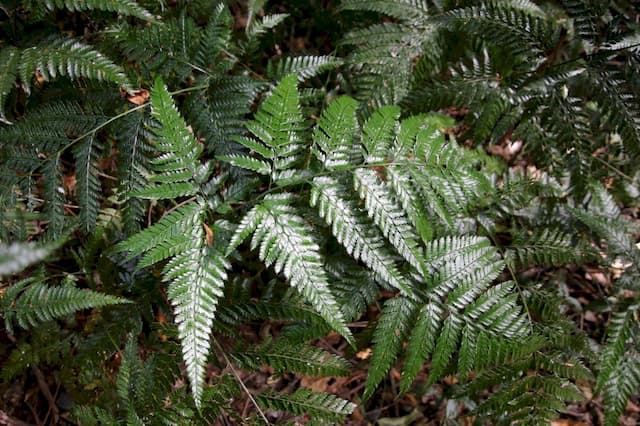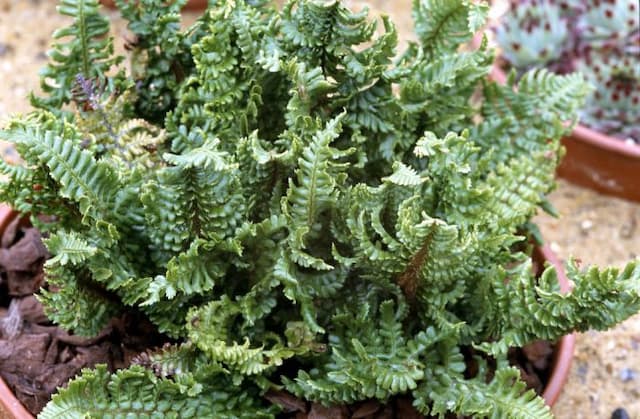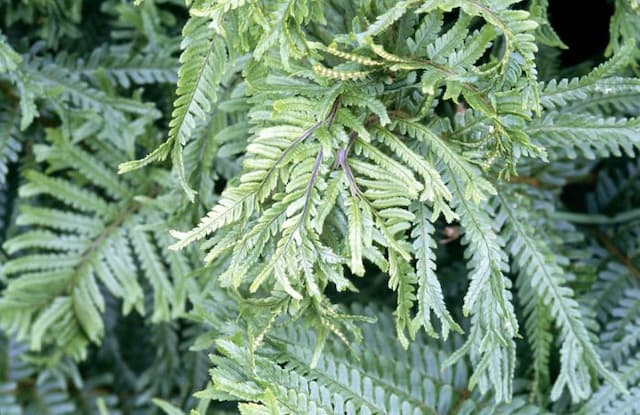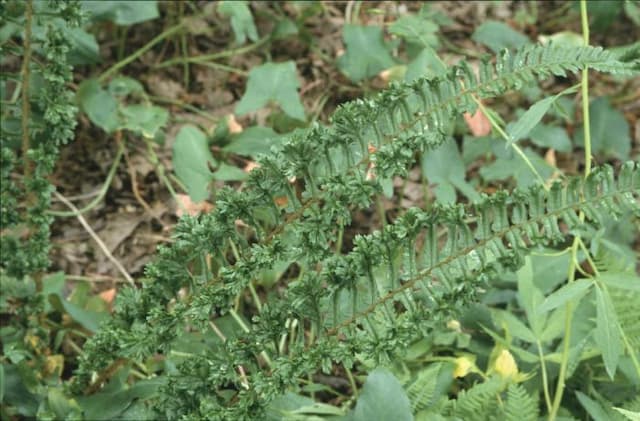Golden-scaled male fern Dryopteris affinis
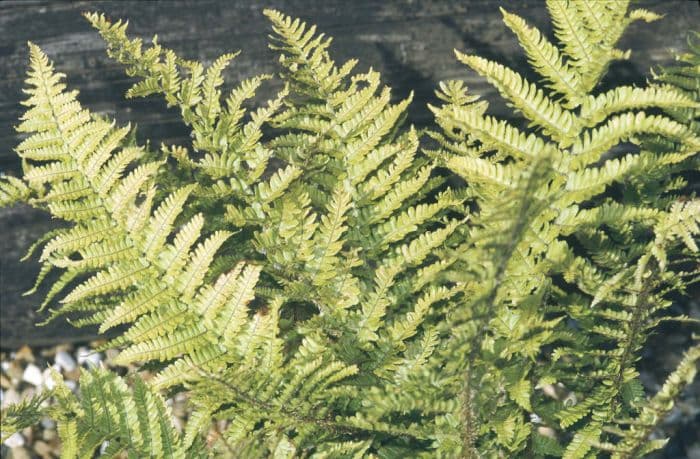
ABOUT
Dryopteris affinis, known as the golden-scaled male fern, is a visually striking plant primarily known for its lush greenery. It features a rosette of arching fronds which unfurl from a central point, giving it a graceful, fountain-like appearance. The fronds themselves are compound, with numerous small leaflets lining each side of a central stalk. These leaflets have a delicate, finely-toothed edge which adds to the fern's intricate texture. As the common name suggests, the fronds' stalks and the undersides are often adorned with golden-brown scales that give the plant a distinctive look. During the early stages of growth, the fronds emerge with a charming rolled-up appearance at the tips, known as fiddleheads, which gradually unfurl as they mature. The overall form of the golden-scaled male fern is dense and bushy, creating a substantial presence wherever it grows. It has a certain hardiness and shade tolerance, thriving under the canopy of larger plants or trees, adding tranquility and a touch of wildness to the landscape. The color of the golden-scaled male fern ranges from a bright green to a more subdued green, varying with its exposure to sunlight. The plant does not bear conspicuous flowers or fruits, as is typical of ferns, which reproduce via spores instead. The fronds' underside may exhibit tiny, dot-like spore cases, which release spores for reproduction. These cases are typically brownish in color and arranged in patterns along the underside of the leaflets. The overall appearance of the golden-scaled male fern is of a plant that is both robust and elegant, suitable for adding lush, verdant texture to shaded garden areas.
About this plant
 Names
NamesFamily
Dryopteridaceae
Synonyms
Scaly Male Fern, Golden-scaled Male Fern, Golden Male Fern
Common names
Dryopteris borreri, Dryopteris pseudomas, Aspidium affine, Aspidium lobbianum, Dryopteris affinis var. cambrensis, Dryopteris cambrensis, Lastrea affinis, Nephrodium affine, Nephrodium pseudo-mas, Polystichum affine, Thelypteris affinis.
 Toxicity
ToxicityTo humans
The Dryopteris affinis, commonly known as the scaly male fern, is not widely recognized as a toxic plant to humans. Generally, ferns like the scaly male fern are not considered to be poisonous, and there is limited information on toxicity for human ingestion. However, as with any non-culinary plant, ingesting plant matter that is not meant for consumption can cause gastrointestinal discomfort or other nondescript symptoms. It is always advisable to avoid eating ornamental plants due to the potential for unknown adverse reactions or possible contamination from pesticides.
To pets
The Dryopteris affinis, or scaly male fern, does not have a well-documented toxic effect on pets. Ferns, including the scaly male fern, are not commonly known to be poisonous to animals. Nevertheless, the ingestion of any plant material can potentially lead to mild stomach upset in pets. Symptoms such as drooling, nausea, vomiting, or diarrhea could occur if a pet ingests a significant amount of the plant. In general, it is prudent to prevent pets from ingesting non-food plants to avoid such potential digestive issues.
 Characteristics
CharacteristicsLife cycle
Perennials
Foliage type
Evergreen
Color of leaves
Green
Height
3 feet (0.9 meters)
Spread
3 feet (0.9 meters)
Plant type
Fern
Hardiness zones
5
Native area
Europe
Benefits
 General Benefits
General Benefits- Landscaping: Dryopteris affinis, commonly known as the Golden Male Fern, is widely used in gardens and landscape design due to its attractive foliage.
- Habitat Provision: It provides habitat and shelter for various wildlife, especially invertebrates that thrive in shady, moist conditions.
- Erosion Control: The Golden Male Fern's root system helps stabilize soil and prevent erosion, particularly in shady woodland areas.
- Low Maintenance: As a hardy, fern species, it generally requires minimal care once established, making it a practical choice for low-maintenance gardens.
- Aesthetic Appeal: The lush, green fronds add visual interest and a calming green backdrop in gardens throughout the year.
- Biodiversity: Planting Dryopteris affinis can contribute to the biodiversity of a garden ecosystem, supporting a range of organisms.
 Medical Properties
Medical Properties- This plant is not used for medical purposes.
 Air-purifying Qualities
Air-purifying QualitiesThis plant is not specifically known for air purifying qualities.
 Other Uses
Other Uses- The leaves of the golden-scaled male fern can be used as a natural insect repellent when dried and burned, which may discourage insects from certain areas.
- Soil erosion control is an ecological benefit provided by golden-scaled male fern, as its root system helps to stabilize the soil in woodland areas.
- Due to its robustness, the golden-scaled male fern is often used in landscaping to fill in shady areas where other plants might struggle to thrive.
- The fern can be used as a natural dye; the foliage can produce various shades of green to brown colors when used in fabric dyeing processes.
- In craft industries, dried fronds of the golden-scaled male fern are sometimes incorporated into floral arrangements and wreaths for texture and visual interest.
- Garden designers sometimes use the texture and form of the fern to provide contrast or as a backdrop to flowering plants in shaded garden beds.
- The golden-scaled male fern is occasionally used in education, where students study its growth patterns and reproductive cycle as a part of botany and biology curriculum.
- In thematic garden designs, like those emulating woodland or forest scenes, the fern can be a prominent feature for its dense and feathery foliage.
- During the Victorian era, the fronds of ferns, including the golden-scaled male fern, were pressed and framed as a part of the popular pastime of collecting and preserving plants.
- Culinary experimentation has seen the use of young, tightly coiled fern fiddleheads as a food garnish, although it's not common practice with the golden-scaled male fern specifically.
Interesting Facts
 Feng Shui
Feng ShuiThe Golden Shield Fern is not used in Feng Shui practice.
 Zodiac Sign Compitability
Zodiac Sign CompitabilityThe Golden Shield Fern is not used in astrology practice.
 Plant Symbolism
Plant Symbolism- Resilience: Dryopteris affinis, commonly known as the Scaly Male Fern, often grows in challenging environments such as rocky areas and woodland floors, symbolizing adaptability and the ability to thrive in difficult conditions.
- Endurance: As a perennial, the Scaly Male Fern returns year after year, representing endurance and the concept of withstanding time and adversity.
- Shelter: The Scaly Male Fern provides cover for small wildlife, thus symbolizing protection and safety.
- Growth: The fern's life cycle, including its growth from spores to full fronds, symbolizes personal growth or expansion of consciousness.
- Secretiveness: With the fern's ancient lineage and mysterious reproductive cycle, it can symbolize hidden knowledge or the unknown.
 Water
WaterThe Golden Male Fern, commonly known as Dryopteris affinis, prefers consistent moisture and should not be allowed to dry out completely. Water the plant deeply once a week with approximately one gallon of water, ensuring the soil is moist but not waterlogged. During warmer months or in dry conditions, you might need to water it twice a week. Cut back on watering during the cooler months to prevent root rot, but ensure the soil stays slightly moist at all times.
 Light
LightThe Golden Male Fern thrives in partial to full shade. It should be placed in a location away from direct sunlight, which can scorch its fronds. A spot under a tree or on the north side of a building where it can receive gentle, filtered light, particularly morning light with afternoon shade, would be ideal for this fern.
 Temperature
TemperatureThe Golden Male Fern is hardy and can tolerate a range of temperatures, but it grows best between 60 and 70 degrees Fahrenheit. This plant can survive temporary dips to about 50 degrees Fahrenheit but should not be subjected to temperatures below freezing. Ideal growing conditions will maintain a consistent temperature above 55 degrees Fahrenheit to ensure good growth.
 Pruning
PruningPruning the Golden Male Fern is primarily done to remove dead or damaged fronds, maintaining its tidy appearance. Pruning can be done as needed throughout the growing season, but major pruning is best performed in early spring before new growth starts. Do not prune more than one-third of the plant at a time, to avoid stressing it.
 Cleaning
CleaningAs needed
 Soil
SoilThe Golden-scaled male fern (Dryopteris affinis) thrives in moist, well-drained soil rich in organic matter. A mix of one part garden soil, one part peat, and one part perlite or coarse sand is ideal. The soil pH should be slightly acidic to neutral, ranging from 6.0 to 7.0, to support healthy growth.
 Repotting
RepottingThe Golden-scaled male fern should be repotted every two to three years or once the roots start to crowd the pot. It's best to repot in the spring before the new fronds emerge to minimize stress on the plant.
 Humidity & Misting
Humidity & MistingThe Golden-scaled male fern prefers high humidity levels, ideally between 60% to 70%. In environments with lower humidity, the use of a humidifier or regular misting can help maintain optimal conditions for the plant to thrive.
 Suitable locations
Suitable locationsIndoor
Place Golden-scaled male fern in indirect light, ensure high humidity, and keep soil consistently moist.
Outdoor
Plant Golden-scaled male fern in shade, ensure soil is well-draining and rich in organic material.
Hardiness zone
4-8 USDA
 Life cycle
Life cycleDryopteris affinis, commonly known as the golden-scaled male fern, begins its life cycle as a spore, which upon finding suitable moist and shaded conditions, germinates to produce a small, heart-shaped gametophyte known as a prothallus. The prothallus supports sexual reproduction, where sperm produced from antheridia swim to fertilize eggs in the archegonia, resulting in a zygote. The zygote then develops into a new sporophyte, initially appearing as a small green rosette that gradually unfurls its fronds as it matures. The fern's fronds, which are complex and pinnate, emerge from a rhizome extending horizontally beneath the soil. As the fern grows, it produces sori on the undersides of the fronds; these sori contain sporangia that eventually release spores when mature, thus completing the reproductive cycle. Throughout its life, the golden-scaled male fern thrives in shady, damp forests and on shaded rock faces and banks, and can spread slowly to form large clumps or colonies.
 Propogation
PropogationPropogation time
Spring-Early Summer
The most popular method of propagating the Golden-scaled male fern, Dryopteris affinis, is through spore collection and sowing. Optimal propagation time typically occurs during the summer months when the spores are ripe. To propagate from spores, collect them from the underside of mature fronds where the sporangia are densely packed. The collected spores are then sown on the surface of a sterilized propagation mix, which should be kept moist and at a consistent temperature of 68-70 degrees Fahrenheit (20-21 degrees Celsius). A transparent cover, like plastic wrap or a propagation dome, can help maintain the needed high humidity for spore germination. In the right conditions, spores will germinate in a few weeks, and the small fern gametophytes will develop. These will eventually give rise to new fern sporophytes, completing the life cycle of the plant.
